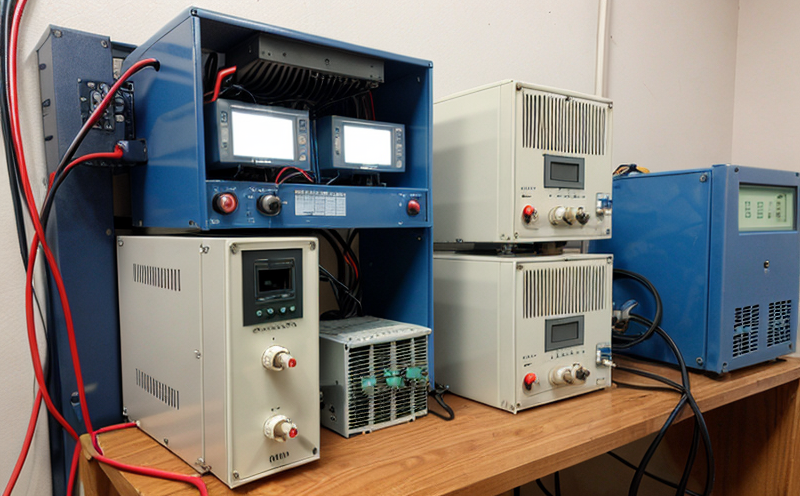EN 50317 Current Collection Quality Testing of Overhead Contact Line Validation Method Development Test
The EN 50317 standard is pivotal in ensuring the safety, reliability, and efficiency of railway overhead contact lines (OCLs). This standard specifies the methodology for validating the current collection quality between a pantograph and an OCL. The testing procedure aims to identify any potential issues that could lead to poor electrical performance, which might compromise both passenger safety and operational timetables.
The EN 50317 test is particularly critical in regions where high-speed trains operate at speeds exceeding 250 km/h. In such environments, the slightest deviation from optimal current collection quality can result in significant disruptions to service schedules and increased maintenance costs. The development of a robust validation method ensures that all components of the OCL system are functioning as intended under real-world conditions.
The testing process involves several key steps: specimen preparation, apparatus setup, data acquisition, and analysis. Specimen preparation is crucial; it includes cleaning the pantograph head and ensuring the contact wire is free from contaminants such as oil or dust. The test rig must be set up to simulate actual operating conditions, which may involve varying levels of temperature, humidity, and voltage.
Data acquisition plays a vital role in this process. Sensors are strategically placed along the OCL to capture current flow characteristics accurately. This data is then analyzed using advanced algorithms that compare it against predefined acceptance criteria specified in EN 50317. The test results provide insights into any anomalies or weaknesses within the system, enabling timely interventions before they escalate into operational problems.
The importance of this testing cannot be overstated. By adhering to strict methodologies outlined in EN 50317, railway operators can ensure their infrastructure meets stringent international standards. This not only enhances passenger safety but also contributes towards reducing disruptions due to unexpected failures or malfunctions.
Real-world applications underscore the significance of this testing procedure. For instance, during high-speed train operations, even minor fluctuations in current collection quality could lead to increased wear and tear on both pantographs and contact wires. Regular validation ensures these components remain aligned with manufacturer specifications throughout their service life.
In summary, EN 50317 Current Collection Quality Testing of Overhead Contact Line Validation Method Development Test is essential for maintaining the integrity and performance of railway overhead contact lines. Its implementation ensures safe and efficient train operations while minimizing maintenance costs associated with suboptimal current collection quality.
Why It Matters
The reliability and efficiency of a railway system are directly linked to its ability to provide uninterrupted power supply to trains traversing overhead contact lines (OCLs). Poor current collection between the pantograph and OCL can lead to several adverse consequences, including increased wear and tear on both components, reduced availability due to frequent breakdowns, and ultimately, passenger dissatisfaction.
Given that modern rail networks operate under increasingly stringent safety regulations and customer expectations for seamless travel experiences, it is imperative for railway operators to adopt comprehensive testing protocols like those prescribed by EN 50317. These standards not only enhance the overall performance of OCL systems but also play a crucial role in safeguarding public health and fostering sustainable transportation solutions.
Moreover, compliance with international norms such as these helps establish trust among stakeholders including passengers, regulatory bodies, and investors. It demonstrates commitment to maintaining high-quality infrastructure that supports long-term economic growth while ensuring environmental sustainability.
Benefits
The adoption of EN 50317 Current Collection Quality Testing brings numerous advantages across various dimensions:
- Enhanced Safety: By identifying potential risks early on, this testing ensures that all systems operate safely and efficiently.
- Improved Reliability: Regular validation helps maintain consistent performance levels, thereby enhancing the reliability of railway operations.
- Cost Savings: Preventive maintenance strategies enabled by these tests reduce unexpected downtime and associated costs.
- Sustainability: Efficient use of resources contributes to reduced environmental impact through optimized energy consumption patterns.
- Regulatory Compliance: Adhering to international standards helps railway operators meet regulatory requirements, fostering confidence among stakeholders.
- Enhanced Reputation: Demonstrating a commitment to best practices enhances an organization's reputation within the industry and beyond.
In conclusion, implementing EN 50317 not only improves technical performance but also strengthens organizational capabilities in meeting broader societal needs related to safety, sustainability, and economic stability.
Competitive Advantage and Market Impact
The implementation of advanced testing protocols like those specified in EN 50317 provides railways with significant competitive advantages. Firstly, it allows operators to demonstrate their commitment to maintaining the highest standards of safety and quality, thereby enhancing customer trust. Secondly, by identifying and addressing potential issues early through rigorous validation methods, railway companies can minimize disruptions caused by unforeseen failures or malfunctions.
Furthermore, compliance with international norms such as EN 50317 helps establish credibility among stakeholders including passengers, regulatory bodies, and investors. This fosters a positive image that supports long-term growth strategies while ensuring environmental sustainability. Lastly, maintaining robust OCL systems through regular validation ensures continuous improvement in operational efficiency, which is crucial for remaining competitive in today’s rapidly evolving market landscape.
For procurement teams seeking reliable suppliers of railway equipment, adherence to EN 50317 is a key criterion. Suppliers who meet these stringent requirements are likely to provide higher-quality products and services, ultimately leading to more efficient and safer rail operations.





